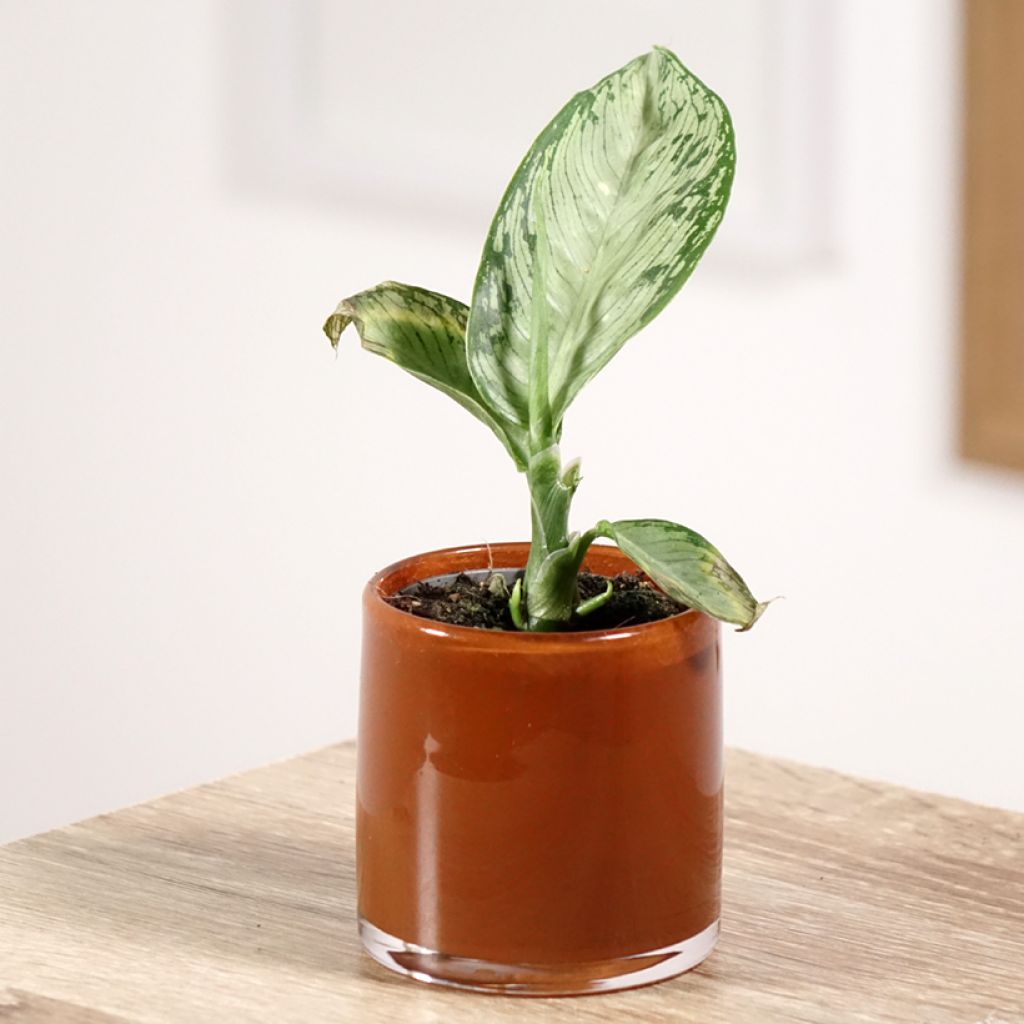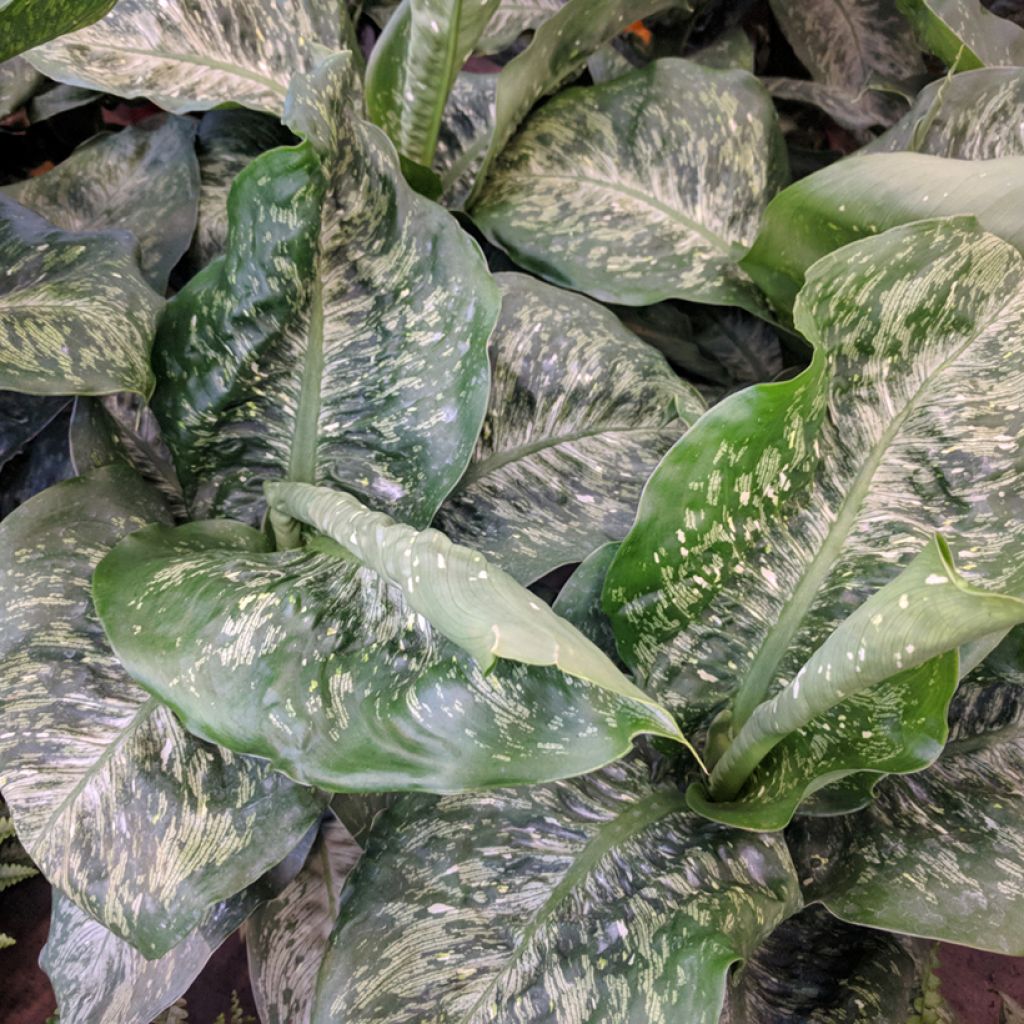

Dieffenbachia seguine Tropic Snow - Dumb canes


Dieffenbachia seguine Tropic Snow - Dumb canes
Dieffenbachia seguine Tropic Snow - Dumb canes
Dieffenbachia seguine Tropic Snow
Dumb canes
This item cannot be shipped to the selected country
Delivery charge from 6,90 €
More information
Shipping country:
-
-
-
-
-
-
-
-
-
-
-
-
-
-
-
-
-
-
-
-
-
-
-
-
-
-
-
-
-
-
-
-
Schedule delivery date,
and select date in basket
This plant carries a 30 days recovery warranty
More information
We guarantee the quality of our plants for a full growing cycle, and will replace at our expense any plant that fails to recover under normal climatic and planting conditions.
From 7,90 € for pickup delivery and 6,90 € for home delivery
Express home delivery from 8,90 €.
Description
The Dieffenbachia 'Tropic Snow' is a popular houseplant prized for its strongly cream-white speckled foliage, as if snow had fallen on its leaves. This variety brings exoticism and light to your interior whatever your decor style. Suited to contemporary or 'jungle' styles, it will find its place in a bright living room or well-lit office. Place it near an east- or west-facing window, or behind a sheer curtain to filter the light. This plant must be watered exclusively with non-calcareous water.
The Dieffenbachia 'Tropic Snow' is a cultivar of the Dieffenbachia seguine species, a tropical species native to the humid forests of Central and South America, and the Caribbean, belonging to the Araceae family. This variety stands out for its ornamental foliage and vigorous growth. Depending on growing conditions, this upright plant reaches a height of 60 cm to 1.20 m indoors, with a spread of 50 to 80 cm. The leaves measuring between 20 and 40 cm in length have a smooth texture and a bright green colouration speckled with white or cream spots and marbling that are more intense at the centre of the lamina. Flowering of the Dieffenbachia 'Tropic Snow' is rare indoors and unspectacular, manifesting as spadix inflorescences surrounded by a greenish spathe. In cultivation, the Dieffenbachia 'Tropic Snow' requires bright light without direct sun exposure which could scorch its delicate foliage. Moderate to high ambient humidity is recommended to replicate its natural habitat, along with a stable temperature between 18 and 24°C. It is essential to keep the substrate slightly moist, avoiding excess water that could lead to root rot.
Warning - The common name "dumb cane" attributed to the Dieffenbachia stems from the toxicity of this plant. Its sap contains calcium oxalate crystals which, if ingested, cause severe irritation of the mouth and throat, leading to swelling of the mucous membranes and temporary paralysis of the vocal cords. It is therefore recommended to handle this plant with caution.
The Dieffenbachia 'Tropic Snow' will thrive in a bright room such as a living room or office where its tropical beauty can be fully admired. Placed near a large window filtered by sheer curtains, it will fit perfectly into modern, Scandinavian, or bohemian décors where its marbled foliage will add brightness and freshness. To showcase it, choose a stylish white or black ceramic pot, or place it on a minimalist display on a shelf. It can also complement a green corner alongside other tropical plants like a Dracaena or an Aspidistra to create a harmonious and soothing indoor oasis.
Report an error about the product description
Dieffenbachia seguine Tropic Snow - Dumb canes in pictures


Foliage
Plant habit
Flowering
Botanical data
Dieffenbachia
seguine
Tropic Snow
Araceae
Dumb canes
Cultivar or hybrid
Safety measures
atteintescutaneomuqueuses
Cette plante peut provoquer l'apparition de réactions cutanées indésirables, une atteinte des yeux, ou des difficultés respiratoires si elle est ingérée.
Ne la plantez pas là où de jeunes enfants peuvent évoluer. Evitez tout contact avec la peau: privilégiez l'emploi de gants pour la manipuler. En cas de contact, lavez-vous soigneusement les mains et rincez abondamment à l'eau la zone concernée. Lavez les vêtements entrés en contact. En cas de réaction cutanée, contactez votre médecin ou le centre antipoison le plus proche de chez vous. En cas d'atteinte étendue ou de difficultés respiratoires, appelez immédiatement le 15 ou le 112.Pensez à conserver l'étiquette de la plante, à la photographier ou à noter son nom, afin de faciliter le travail des professionnels de santé.
Davantage d'informations sur https://plantes-risque.info
Location
Location
Maintenance and care
Potting advice, substrates and fertilisers
Houseplant care
Disease and pest advice
Maintenance and care
This item has not been reviewed yet - be the first to leave a review about it.
Haven't found what you were looking for?
Hardiness is the lowest winter temperature a plant can endure without suffering serious damage or even dying. However, hardiness is affected by location (a sheltered area, such as a patio), protection (winter cover) and soil type (hardiness is improved by well-drained soil).

Photo Sharing Terms & Conditions
In order to encourage gardeners to interact and share their experiences, Promesse de fleurs offers various media enabling content to be uploaded onto its Site - in particular via the ‘Photo sharing’ module.
The User agrees to refrain from:
- Posting any content that is illegal, prejudicial, insulting, racist, inciteful to hatred, revisionist, contrary to public decency, that infringes on privacy or on the privacy rights of third parties, in particular the publicity rights of persons and goods, intellectual property rights, or the right to privacy.
- Submitting content on behalf of a third party;
- Impersonate the identity of a third party and/or publish any personal information about a third party;
In general, the User undertakes to refrain from any unethical behaviour.
All Content (in particular text, comments, files, images, photos, videos, creative works, etc.), which may be subject to property or intellectual property rights, image or other private rights, shall remain the property of the User, subject to the limited rights granted by the terms of the licence granted by Promesse de fleurs as stated below. Users are at liberty to publish or not to publish such Content on the Site, notably via the ‘Photo Sharing’ facility, and accept that this Content shall be made public and freely accessible, notably on the Internet.
Users further acknowledge, undertake to have ,and guarantee that they hold all necessary rights and permissions to publish such material on the Site, in particular with regard to the legislation in force pertaining to any privacy, property, intellectual property, image, or contractual rights, or rights of any other nature. By publishing such Content on the Site, Users acknowledge accepting full liability as publishers of the Content within the meaning of the law, and grant Promesse de fleurs, free of charge, an inclusive, worldwide licence for the said Content for the entire duration of its publication, including all reproduction, representation, up/downloading, displaying, performing, transmission, and storage rights.
Users also grant permission for their name to be linked to the Content and accept that this link may not always be made available.
By engaging in posting material, Users consent to their Content becoming automatically accessible on the Internet, in particular on other sites and/or blogs and/or web pages of the Promesse de fleurs site, including in particular social pages and the Promesse de fleurs catalogue.
Users may secure the removal of entrusted content free of charge by issuing a simple request via our contact form.
The flowering period indicated on our website applies to countries and regions located in USDA zone 8 (France, the United Kingdom, Ireland, the Netherlands, etc.)
It will vary according to where you live:
- In zones 9 to 10 (Italy, Spain, Greece, etc.), flowering will occur about 2 to 4 weeks earlier.
- In zones 6 to 7 (Germany, Poland, Slovenia, and lower mountainous regions), flowering will be delayed by 2 to 3 weeks.
- In zone 5 (Central Europe, Scandinavia), blooming will be delayed by 3 to 5 weeks.
In temperate climates, pruning of spring-flowering shrubs (forsythia, spireas, etc.) should be done just after flowering.
Pruning of summer-flowering shrubs (Indian Lilac, Perovskia, etc.) can be done in winter or spring.
In cold regions as well as with frost-sensitive plants, avoid pruning too early when severe frosts may still occur.
The planting period indicated on our website applies to countries and regions located in USDA zone 8 (France, United Kingdom, Ireland, Netherlands).
It will vary according to where you live:
- In Mediterranean zones (Marseille, Madrid, Milan, etc.), autumn and winter are the best planting periods.
- In continental zones (Strasbourg, Munich, Vienna, etc.), delay planting by 2 to 3 weeks in spring and bring it forward by 2 to 4 weeks in autumn.
- In mountainous regions (the Alps, Pyrenees, Carpathians, etc.), it is best to plant in late spring (May-June) or late summer (August-September).
The harvesting period indicated on our website applies to countries and regions in USDA zone 8 (France, England, Ireland, the Netherlands).
In colder areas (Scandinavia, Poland, Austria...) fruit and vegetable harvests are likely to be delayed by 3-4 weeks.
In warmer areas (Italy, Spain, Greece, etc.), harvesting will probably take place earlier, depending on weather conditions.
The sowing periods indicated on our website apply to countries and regions within USDA Zone 8 (France, UK, Ireland, Netherlands).
In colder areas (Scandinavia, Poland, Austria...), delay any outdoor sowing by 3-4 weeks, or sow under glass.
In warmer climes (Italy, Spain, Greece, etc.), bring outdoor sowing forward by a few weeks.
































